Economic Analysis of Price Control: Rent Control and Its Effects
VerifiedAdded on 2019/09/25
|6
|1352
|284
Essay
AI Summary
This essay examines the economic concept of rent control, positioning it as a price ceiling implemented by governments to regulate housing costs. It explains how rent control leads to market inefficiencies, including shortages in the housing market, as suppliers are unwilling to provide housing at the controlled lower prices while demand remains high. The essay uses diagrams to illustrate the concepts of supply, demand, and deadweight loss resulting from rent control, emphasizing the area of inefficiency created. It also compares rent control to other price control mechanisms and discusses the equity reasons behind such policies. Furthermore, the essay explores alternative policies like inclusionary housing lotteries, rent regulation, and government programs such as the Mitchell-Lama and Section 8 housing vouchers that aim to address housing affordability issues. The essay uses references to support the analysis and provides a comprehensive overview of the economic impacts and policy implications of rent control.

economics
Paraphrase This Document
Need a fresh take? Get an instant paraphrase of this document with our AI Paraphraser
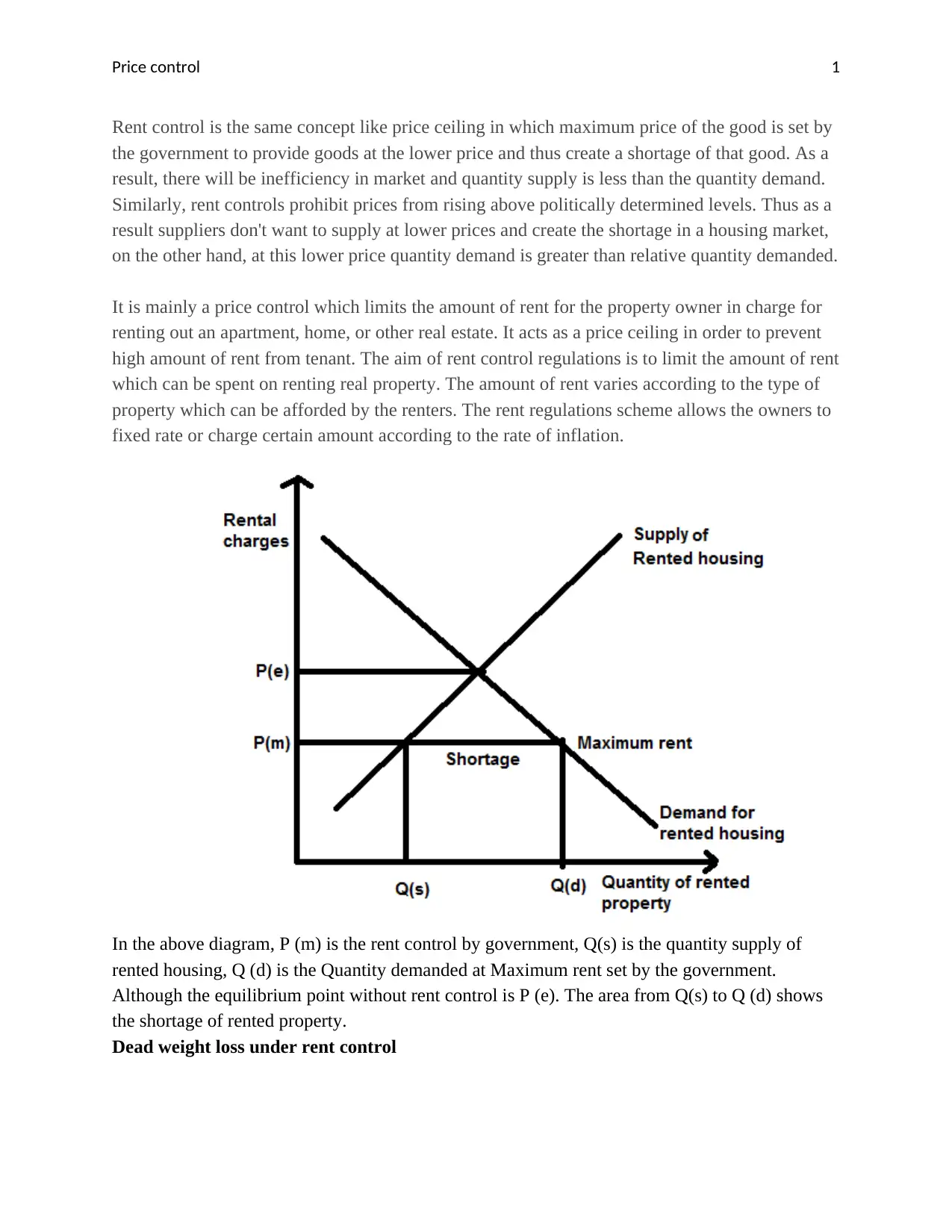
Price control 1
Rent control is the same concept like price ceiling in which maximum price of the good is set by
the government to provide goods at the lower price and thus create a shortage of that good. As a
result, there will be inefficiency in market and quantity supply is less than the quantity demand.
Similarly, rent controls prohibit prices from rising above politically determined levels. Thus as a
result suppliers don't want to supply at lower prices and create the shortage in a housing market,
on the other hand, at this lower price quantity demand is greater than relative quantity demanded.
It is mainly a price control which limits the amount of rent for the property owner in charge for
renting out an apartment, home, or other real estate. It acts as a price ceiling in order to prevent
high amount of rent from tenant. The aim of rent control regulations is to limit the amount of rent
which can be spent on renting real property. The amount of rent varies according to the type of
property which can be afforded by the renters. The rent regulations scheme allows the owners to
fixed rate or charge certain amount according to the rate of inflation.
In the above diagram, P (m) is the rent control by government, Q(s) is the quantity supply of
rented housing, Q (d) is the Quantity demanded at Maximum rent set by the government.
Although the equilibrium point without rent control is P (e). The area from Q(s) to Q (d) shows
the shortage of rented property.
Dead weight loss under rent control
Rent control is the same concept like price ceiling in which maximum price of the good is set by
the government to provide goods at the lower price and thus create a shortage of that good. As a
result, there will be inefficiency in market and quantity supply is less than the quantity demand.
Similarly, rent controls prohibit prices from rising above politically determined levels. Thus as a
result suppliers don't want to supply at lower prices and create the shortage in a housing market,
on the other hand, at this lower price quantity demand is greater than relative quantity demanded.
It is mainly a price control which limits the amount of rent for the property owner in charge for
renting out an apartment, home, or other real estate. It acts as a price ceiling in order to prevent
high amount of rent from tenant. The aim of rent control regulations is to limit the amount of rent
which can be spent on renting real property. The amount of rent varies according to the type of
property which can be afforded by the renters. The rent regulations scheme allows the owners to
fixed rate or charge certain amount according to the rate of inflation.
In the above diagram, P (m) is the rent control by government, Q(s) is the quantity supply of
rented housing, Q (d) is the Quantity demanded at Maximum rent set by the government.
Although the equilibrium point without rent control is P (e). The area from Q(s) to Q (d) shows
the shortage of rented property.
Dead weight loss under rent control
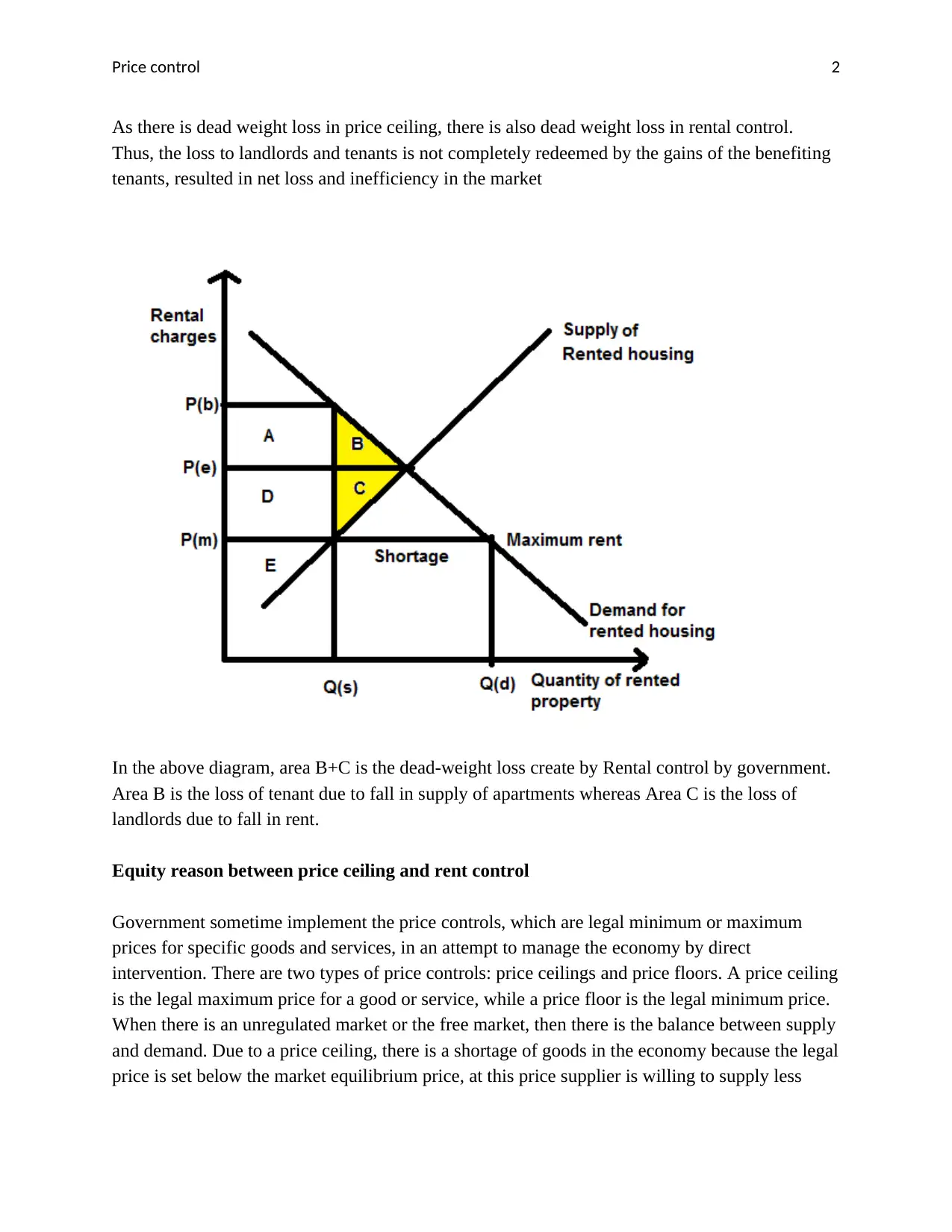
Price control 2
As there is dead weight loss in price ceiling, there is also dead weight loss in rental control.
Thus, the loss to landlords and tenants is not completely redeemed by the gains of the benefiting
tenants, resulted in net loss and inefficiency in the market
In the above diagram, area B+C is the dead-weight loss create by Rental control by government.
Area B is the loss of tenant due to fall in supply of apartments whereas Area C is the loss of
landlords due to fall in rent.
Equity reason between price ceiling and rent control
Government sometime implement the price controls, which are legal minimum or maximum
prices for specific goods and services, in an attempt to manage the economy by direct
intervention. There are two types of price controls: price ceilings and price floors. A price ceiling
is the legal maximum price for a good or service, while a price floor is the legal minimum price.
When there is an unregulated market or the free market, then there is the balance between supply
and demand. Due to a price ceiling, there is a shortage of goods in the economy because the legal
price is set below the market equilibrium price, at this price supplier is willing to supply less
As there is dead weight loss in price ceiling, there is also dead weight loss in rental control.
Thus, the loss to landlords and tenants is not completely redeemed by the gains of the benefiting
tenants, resulted in net loss and inefficiency in the market
In the above diagram, area B+C is the dead-weight loss create by Rental control by government.
Area B is the loss of tenant due to fall in supply of apartments whereas Area C is the loss of
landlords due to fall in rent.
Equity reason between price ceiling and rent control
Government sometime implement the price controls, which are legal minimum or maximum
prices for specific goods and services, in an attempt to manage the economy by direct
intervention. There are two types of price controls: price ceilings and price floors. A price ceiling
is the legal maximum price for a good or service, while a price floor is the legal minimum price.
When there is an unregulated market or the free market, then there is the balance between supply
and demand. Due to a price ceiling, there is a shortage of goods in the economy because the legal
price is set below the market equilibrium price, at this price supplier is willing to supply less
⊘ This is a preview!⊘
Do you want full access?
Subscribe today to unlock all pages.

Trusted by 1+ million students worldwide
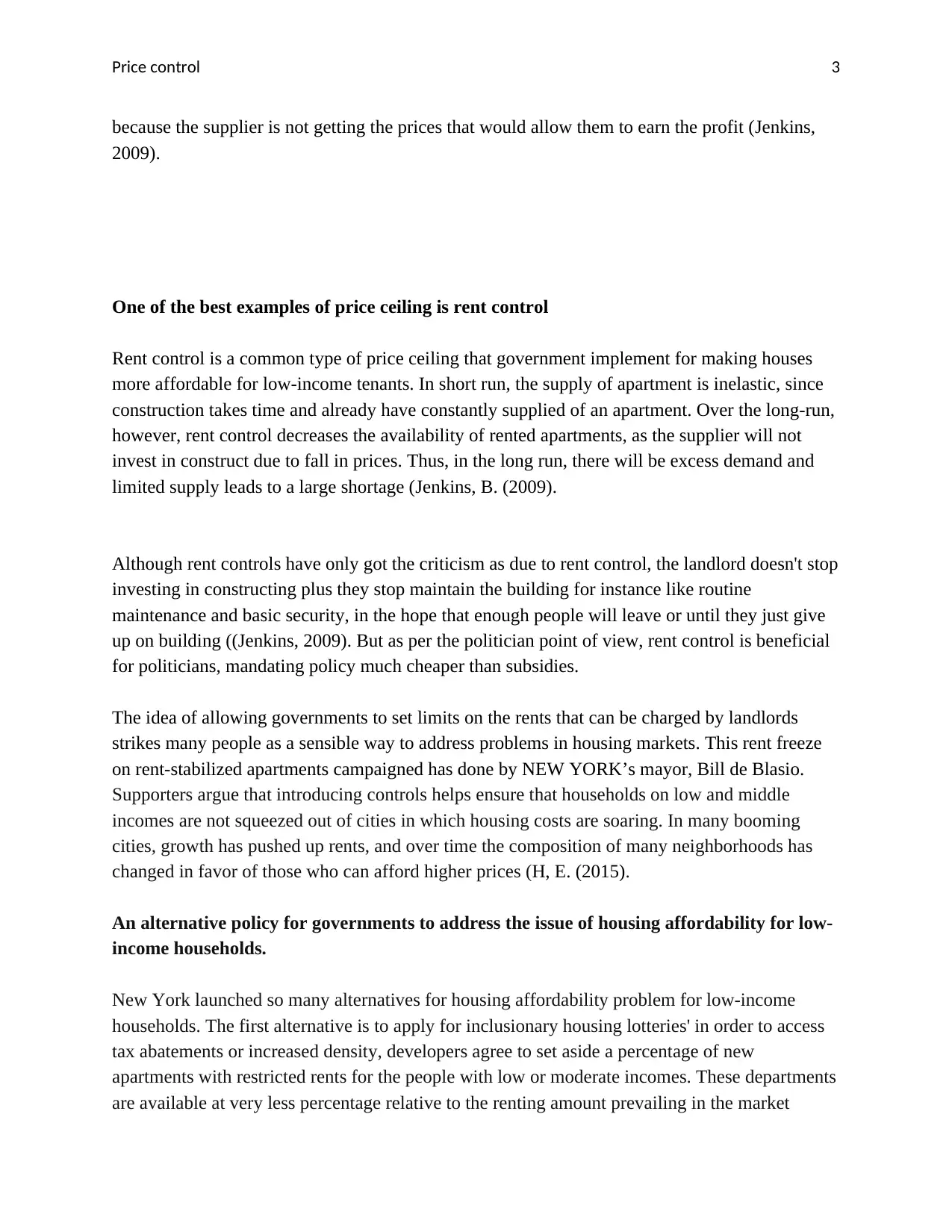
Price control 3
because the supplier is not getting the prices that would allow them to earn the profit (Jenkins,
2009).
One of the best examples of price ceiling is rent control
Rent control is a common type of price ceiling that government implement for making houses
more affordable for low-income tenants. In short run, the supply of apartment is inelastic, since
construction takes time and already have constantly supplied of an apartment. Over the long-run,
however, rent control decreases the availability of rented apartments, as the supplier will not
invest in construct due to fall in prices. Thus, in the long run, there will be excess demand and
limited supply leads to a large shortage (Jenkins, B. (2009).
Although rent controls have only got the criticism as due to rent control, the landlord doesn't stop
investing in constructing plus they stop maintain the building for instance like routine
maintenance and basic security, in the hope that enough people will leave or until they just give
up on building ((Jenkins, 2009). But as per the politician point of view, rent control is beneficial
for politicians, mandating policy much cheaper than subsidies.
The idea of allowing governments to set limits on the rents that can be charged by landlords
strikes many people as a sensible way to address problems in housing markets. This rent freeze
on rent-stabilized apartments campaigned has done by NEW YORK’s mayor, Bill de Blasio.
Supporters argue that introducing controls helps ensure that households on low and middle
incomes are not squeezed out of cities in which housing costs are soaring. In many booming
cities, growth has pushed up rents, and over time the composition of many neighborhoods has
changed in favor of those who can afford higher prices (H, E. (2015).
An alternative policy for governments to address the issue of housing affordability for low-
income households.
New York launched so many alternatives for housing affordability problem for low-income
households. The first alternative is to apply for inclusionary housing lotteries' in order to access
tax abatements or increased density, developers agree to set aside a percentage of new
apartments with restricted rents for the people with low or moderate incomes. These departments
are available at very less percentage relative to the renting amount prevailing in the market
because the supplier is not getting the prices that would allow them to earn the profit (Jenkins,
2009).
One of the best examples of price ceiling is rent control
Rent control is a common type of price ceiling that government implement for making houses
more affordable for low-income tenants. In short run, the supply of apartment is inelastic, since
construction takes time and already have constantly supplied of an apartment. Over the long-run,
however, rent control decreases the availability of rented apartments, as the supplier will not
invest in construct due to fall in prices. Thus, in the long run, there will be excess demand and
limited supply leads to a large shortage (Jenkins, B. (2009).
Although rent controls have only got the criticism as due to rent control, the landlord doesn't stop
investing in constructing plus they stop maintain the building for instance like routine
maintenance and basic security, in the hope that enough people will leave or until they just give
up on building ((Jenkins, 2009). But as per the politician point of view, rent control is beneficial
for politicians, mandating policy much cheaper than subsidies.
The idea of allowing governments to set limits on the rents that can be charged by landlords
strikes many people as a sensible way to address problems in housing markets. This rent freeze
on rent-stabilized apartments campaigned has done by NEW YORK’s mayor, Bill de Blasio.
Supporters argue that introducing controls helps ensure that households on low and middle
incomes are not squeezed out of cities in which housing costs are soaring. In many booming
cities, growth has pushed up rents, and over time the composition of many neighborhoods has
changed in favor of those who can afford higher prices (H, E. (2015).
An alternative policy for governments to address the issue of housing affordability for low-
income households.
New York launched so many alternatives for housing affordability problem for low-income
households. The first alternative is to apply for inclusionary housing lotteries' in order to access
tax abatements or increased density, developers agree to set aside a percentage of new
apartments with restricted rents for the people with low or moderate incomes. These departments
are available at very less percentage relative to the renting amount prevailing in the market
Paraphrase This Document
Need a fresh take? Get an instant paraphrase of this document with our AI Paraphraser
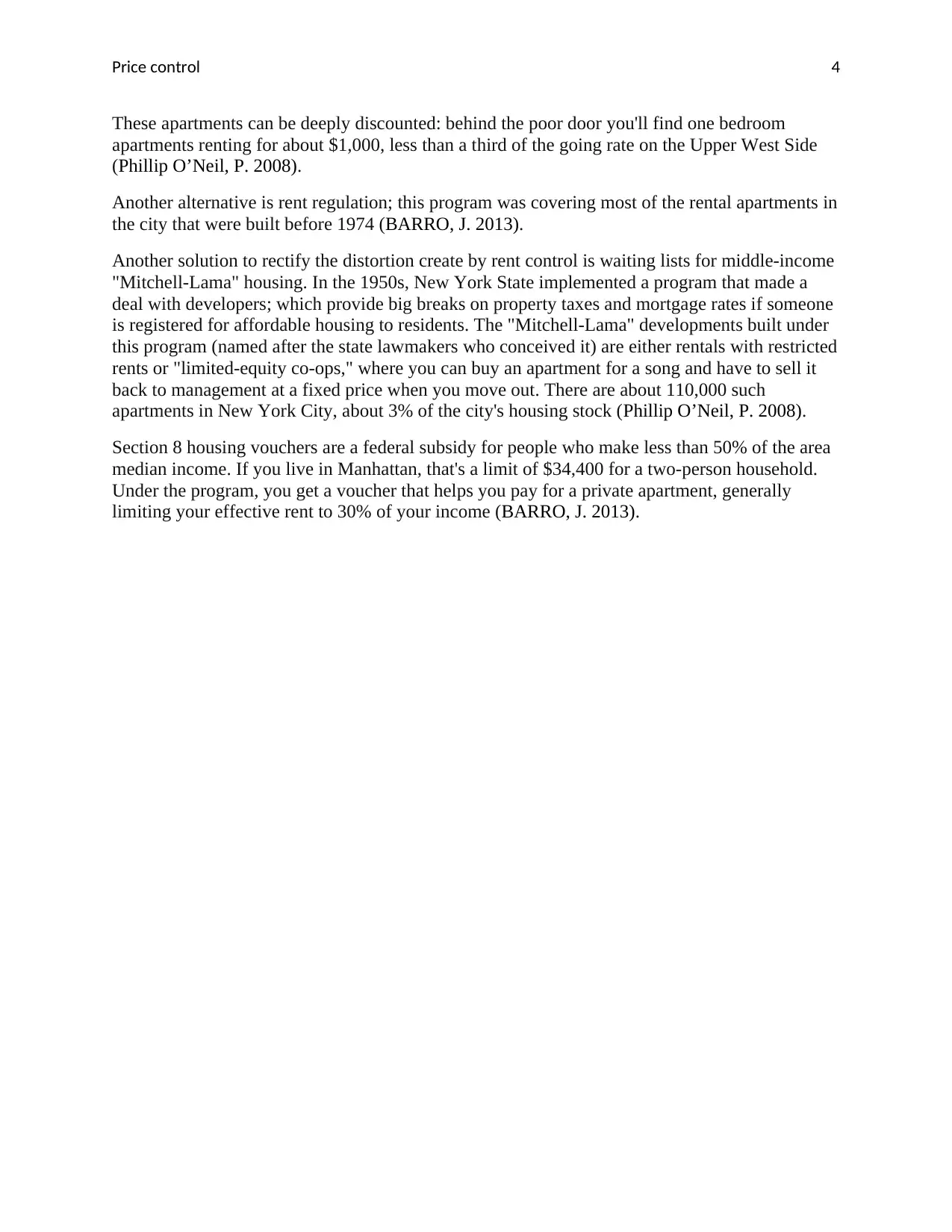
Price control 4
These apartments can be deeply discounted: behind the poor door you'll find one bedroom
apartments renting for about $1,000, less than a third of the going rate on the Upper West Side
(Phillip O’Neil, P. 2008).
Another alternative is rent regulation; this program was covering most of the rental apartments in
the city that were built before 1974 (BARRO, J. 2013).
Another solution to rectify the distortion create by rent control is waiting lists for middle-income
"Mitchell-Lama" housing. In the 1950s, New York State implemented a program that made a
deal with developers; which provide big breaks on property taxes and mortgage rates if someone
is registered for affordable housing to residents. The "Mitchell-Lama" developments built under
this program (named after the state lawmakers who conceived it) are either rentals with restricted
rents or "limited-equity co-ops," where you can buy an apartment for a song and have to sell it
back to management at a fixed price when you move out. There are about 110,000 such
apartments in New York City, about 3% of the city's housing stock (Phillip O’Neil, P. 2008).
Section 8 housing vouchers are a federal subsidy for people who make less than 50% of the area
median income. If you live in Manhattan, that's a limit of $34,400 for a two-person household.
Under the program, you get a voucher that helps you pay for a private apartment, generally
limiting your effective rent to 30% of your income (BARRO, J. 2013).
These apartments can be deeply discounted: behind the poor door you'll find one bedroom
apartments renting for about $1,000, less than a third of the going rate on the Upper West Side
(Phillip O’Neil, P. 2008).
Another alternative is rent regulation; this program was covering most of the rental apartments in
the city that were built before 1974 (BARRO, J. 2013).
Another solution to rectify the distortion create by rent control is waiting lists for middle-income
"Mitchell-Lama" housing. In the 1950s, New York State implemented a program that made a
deal with developers; which provide big breaks on property taxes and mortgage rates if someone
is registered for affordable housing to residents. The "Mitchell-Lama" developments built under
this program (named after the state lawmakers who conceived it) are either rentals with restricted
rents or "limited-equity co-ops," where you can buy an apartment for a song and have to sell it
back to management at a fixed price when you move out. There are about 110,000 such
apartments in New York City, about 3% of the city's housing stock (Phillip O’Neil, P. 2008).
Section 8 housing vouchers are a federal subsidy for people who make less than 50% of the area
median income. If you live in Manhattan, that's a limit of $34,400 for a two-person household.
Under the program, you get a voucher that helps you pay for a private apartment, generally
limiting your effective rent to 30% of your income (BARRO, J. 2013).
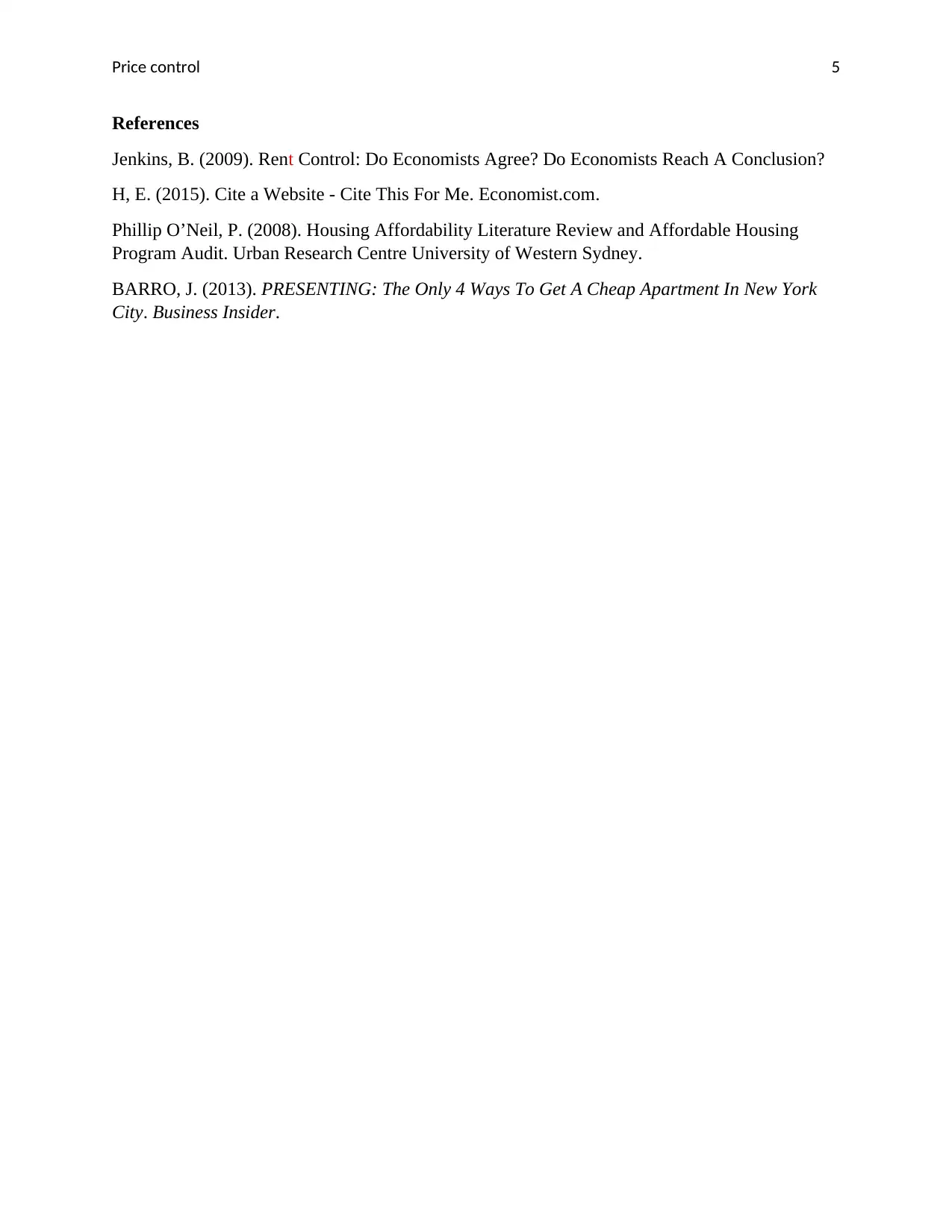
Price control 5
References
Jenkins, B. (2009). Rent Control: Do Economists Agree? Do Economists Reach A Conclusion?
H, E. (2015). Cite a Website - Cite This For Me. Economist.com.
Phillip O’Neil, P. (2008). Housing Affordability Literature Review and Affordable Housing
Program Audit. Urban Research Centre University of Western Sydney.
BARRO, J. (2013). PRESENTING: The Only 4 Ways To Get A Cheap Apartment In New York
City. Business Insider.
References
Jenkins, B. (2009). Rent Control: Do Economists Agree? Do Economists Reach A Conclusion?
H, E. (2015). Cite a Website - Cite This For Me. Economist.com.
Phillip O’Neil, P. (2008). Housing Affordability Literature Review and Affordable Housing
Program Audit. Urban Research Centre University of Western Sydney.
BARRO, J. (2013). PRESENTING: The Only 4 Ways To Get A Cheap Apartment In New York
City. Business Insider.
⊘ This is a preview!⊘
Do you want full access?
Subscribe today to unlock all pages.

Trusted by 1+ million students worldwide
1 out of 6
Related Documents
Your All-in-One AI-Powered Toolkit for Academic Success.
+13062052269
info@desklib.com
Available 24*7 on WhatsApp / Email
![[object Object]](/_next/static/media/star-bottom.7253800d.svg)
Unlock your academic potential
Copyright © 2020–2025 A2Z Services. All Rights Reserved. Developed and managed by ZUCOL.





